Letters From Andy
Uncategorized
Weddings don’t have to be Expensive to be Wonderful!
Do your wedding on a budget you can afford. In 2022 the average wedding was 30,000. Imagine what you could do with $25,000 if you only spent $5000 on your special day!
The best way to reduce the cost of any wedding is to budget and then enlist friends and family. They usually love to participate and often feel like they are a big part of your day when they have a role to play. What a gift! There are countless ways to help make them a part of putting on your wedding and at the same time helping you keep the cost at a minimum.
GUEST COUNT: Think small. Venues that provide space for 60 or less people are very inexpensive compared to the larger outdoor or fancy indoor spaces. Refine your list and find other ways to get together to celebrate with the people that don’t make the wedding cut. Less people means more intimate time spent with each guest and gives you a chance to feel like you engaged in your wedding celebration.
EVENT COORDINATOR: Find your friend(s) who is the most detailed oriented and ask them to oversee some of the most important parts of the day. Maybe its more than one friend, delegate where possible.
INVITES:Find your techy friend to help you get your invite out on-line. Forgo the paper invitation. Do your, save the date, invite and RSVP on line.
VENUE: Find your friends that love to decorate and have them be in charge of helping create the venue theme. Records show that couples spend the most on the Venue. Find a more low cost and non-traditional site, a venue that has a nice backdrop where lots can be done with a low-cost budget to address your theme or particular tastes in décor.
FLOWERS: Find your friends that are crafty and love flowers. Flowers can become one of the higher costs of a wedding. Find a venue that has an abundance of flowers that can be used for decorating your space including the tables and wedding vows area. These days there are lots of beautiful $30 bouquets, it does not have to be done by a florist.
CATERING:Food Truck Dining delivered to the table (use order cards to get specifics, which are filled out ahead of time and numbered by table. Or bring in the chef that can cook it in the pizza oven or over the fire.
PHOTOGRAPHY: Splurge on the photographer or ask a friend with more skill then your regular iPhone photographers to record your special day. Reduce the hours that you need the photographer to just the most important part of the day and then have others capture the party and after photos.
RENTALS:Grounds that provide enough space for 60 people to dine and enjoy the party. Consider the types of tables and chairs needed and what you need to put on the tables. It doesn’t have to be potluck to be less expensive and still be grand.
MUSIC: The sky is the limit. Live music vs a DJ. So many choices, so many prices.
OFFICIANT: Perhaps one of your friends is qualified or has been dreaming of becoming a wedding officiate or look to your spiritual center for guidance in finding a leader in your faith.
GOWNS, SUITS, RINGS AND ALL OF THE SPECIAL THINGS! Find the items that fit your budget and style, you don’t need the $5000 dollar gown to have a beautiful wedding. Pick the areas that are most meaningful and put your money there while cutting as much of the fluff of other areas where possible. The most important thing is having fun and feeling like your day was special with family and friends!
Fathers
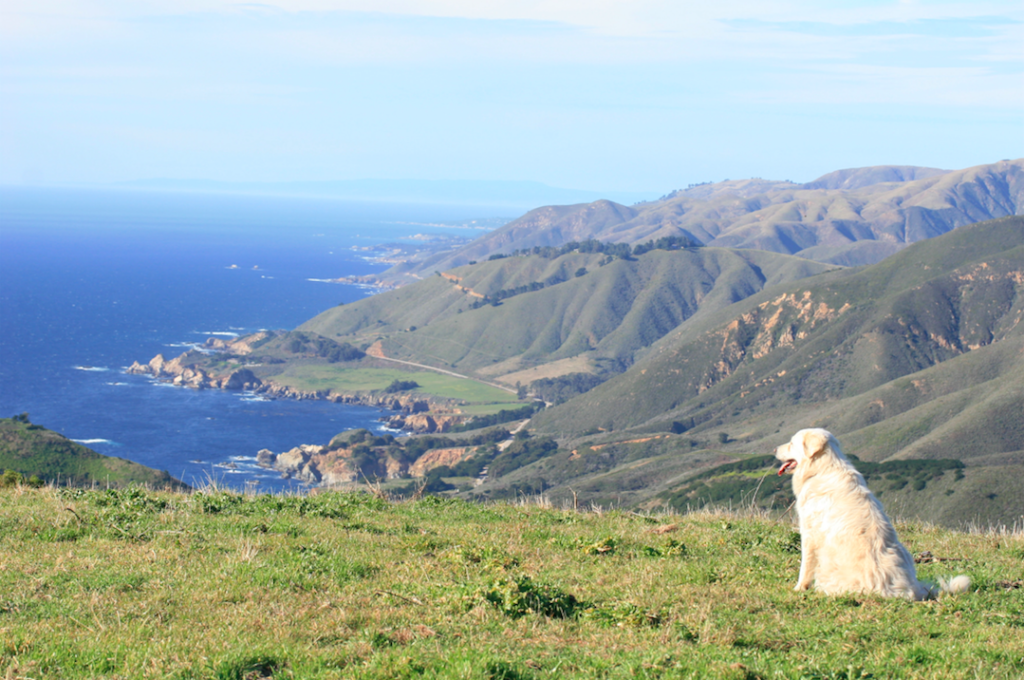
Last Sunday was Father’s Day and my two kids each called me up, which felt nice. They both live quite a ways away and with the Covid precautions in place I haven’t seen them in a while. A couple of weeks ago Starling and I took a drive up the Tassajara Road into the Los Padres National Forest to the top of Chew’s Ridge. I used to go up there with my father, who was a botanist and did a lot of research on the ridge. Our family scattered my father’s ashes there years ago and I like to visit the spot from time to time. The view is magnificent from the old fire lookout tower; you can see into the heart of the Ventana Wilderness and look down the spine of the Santa Lucia Mountain Range stretching south. The blue line of the Pacific is clear to the west behind Big Sur, and the arc of the Monterey Bay with Santa Cruz County, where I live now, lies on the northern horizon. I grew up at the foot of this mountain up a canyon to the east, so taking in the view of the scenery around me inevitably prompts me to look inward too at my own life. Being a father has given me more joy than anything else and it’s brought its share of challenges and worries. I find myself looking back at my own father’s example for guidance and contrast, and of course I wish that he had lived to see my kids growing up.
My father could tell a good story, but he rarely talked about himself, making it seem as though he’d come into the world as a thirty something with a PhD. Most of what I know about his early life I learned from his big brother, George, who once said that the family lived on so many ranches up and down the Salinas Valley that their true home was Highway 101. Every once in a while my dad would let a detail slip, like one day when he and I were heading out of King City into the San Benito Mountains and we passed Metz Road. He mentioned that during the Depression there was a vegetable dump on Metz Road where the local farmers buried truckloads and truckloads of turnips in an effort to reduce oversupply and keep the prices up. His mother would have him walk Metz road and pick up the turnips that had fallen off the overloaded turnip trucks. The tone of his voice let me know why we never ate turnips in our house. Nowadays I think about that moment and compare his “life on the farms” as a child of farm workers, with my kids’ lives growing up on a farm.
When my daughter, Lena, was around five years old she was playing in the yard with her friend, Lydia. I had been invited to speak to a group at Stanford University on the subject of preserving small farms and the relevance and value of a diverse agricultural landscape and local foodshed. After the talk there was to be a meet and mingle in the Rodin Sculpture Garden with food provided by Jesse Cool’s Flea Street Cafe. It was almost time to leave for the event, so I went out to tell the girls they needed to wrap it up. The girls were disappointed. “What’s wrong?” Lydia asked. “How come I have to go home?” Lena was scowling. “Because I have to go to some stupid gourmet thing,” Lena replied. It cracked me up- I was probably in my early 20s before I ever used the word “gourmet” in conversation, and then it hadn’t been a slur. It made me think about turnips though. I’m sure that my grandmother boiled the turnips my dad picked up off the road to DEATH, because that’s how she cooked them for me when I was a kid visiting her. And, like my father before me, I hated them. But the “gourmet” crowd I fell into through my involvement in the organic produce industry taught me how to take baby turnips, dress them lightly in olive oil and roast them. Super tasty! My kids survived their turnips. Dad would have enjoyed watching me try to get them to eat their veggies. Lena grew up to be a vegetarian and she keeps a garden, while Graydon has made a hobby out of learning to cook Chinese food, so it all worked out.

My father, like so many fathers before him, got smarter and smarter the older I got. Once I became a father myself I felt like I began to know him in a whole new way, even though he was slipping away into early onset Alzheimers. These days my kids call me sometimes, even when it’s not Fathers’ Day. Lena had a question last week about growing basil, and Graydon called about how to cook lentils. Maybe I’m starting to get smarter too. Now that I’m 60 my father is looking very wise. He was 27 when I was born, and by that time he’d already lived through the Great Depression, survived tuberculosis, done his share of farm labor, been a forest fire fighter, served as an officer in the US Navy in the Tonkin Gulf and South China Sea, and was well on his way to earning a doctorate. At 26 he probably didn’t know any more about raising kids than I did at 35 when my first child was born but he learned on the job, the way we all do. He’d be great to talk to now about how to be a father to young adults. I miss him.
Today Fidel, who is our foreman in our greenhouse, is in the hospital with his wife, who has just gone into labor. The child will be their first. I’m happy for them.
Stay well and all the best from Andy and the crew at Mariquita Farm.
© 2020 Essay by Andy Griffin.
Top photo: View from Serra Hill, Big Sur, circa 2012, by Andy Griffin.
Bottom photo: Andy’s father standing beside a crop duster.
Black Lives Matter
Have you seen photos or videos of the Black Lives Matter demonstrations in the Mission District of San Francisco? Maybe you were there, or perhaps you were present at any one of the other innumerable protests across America, and even across the world. We ARE in a moment of political and social change, all the more intense for being so long in coming. And Juanita Bruton has been in the thick of it in San Francisco. She’s “witchwithplants” on Instagram. “It feels strange to try to promote my business during a time like this,” She writes, “but I love growing things and we are growing the future.” Juanita has just started her own small company as a garden designer and plant consultant in San Francisco.

I got a chance to work with Juanita for a number of years when she was a produce manager at the BiRite stores. When she announced she would be leaving BiRite it made me sad because she was easy to work with, cheerful, and a good communicator. I saw her departure as just another example of a disturbing trend in the City that has seen ever higher rent pushing out the people who aren’t pulling down high tech salaries. But when I learned that she’d moved on from BiRite to start her own plant business in the city it made me happy. Plant people are my tribe, and I’d been wondering when the plants in Juanita’s life were going to grow to such a number that their cumulative gravitational pull would draw her away from retail into a more botanical orbit.
When I saw Juanita’s Instagram post I was immediately reminded of an old bromide that runs something like this:
What’s the best time to plant a tree?
Thirty Years ago.
What’s the second best time to plant a tree?
Today.
A good business is like a tree. It is rooted in the community. Its canopy provides shelter for the people who care for and about it, and its fruits sustain them. Juanita started a business to create gardens for people, and to help people learn to care for the plants around them. If she had started her business a while ago it might already have grown strong enough to withstand all the cross currents that are buffeting the business environment these days; pandemic, epic homelessness, economic collapse, insane rents, police violence…there’s lots going on right now. “Having my hands in the dirt again recently and tending to my plants and this garden has been soothing to my soul,” she said in her post. I’m sure it has, just as I know that gardens sooth the souls of all the people who visit them. Gardening and farming are by their very nature hopeful, nurturing enterprises.
With the streets full of protest, the hospitals full of suffering people, and the Congress and White House crowded with lobbyists for billionaires hustling politicians for hire it would seem poor timing to start a little gardening business. But businesses succeed when they solve problems, and our country and cities have so many problems that gardens can solve. And when a garden can’t make a food desert turn green, at least it can offer the peaceful refuge we as citizens need for proper calm and meditation so that we can more thoughtfully cultivate solutions.
And it’s not like Juanita should wait to plant until the war on the Black Americans resolves into peace; we’re already over 400 years into this mess. But maybe- hopefully- we’ve come to a real turning point in our nation’s trajectory. With 40 million people unemployed, many of them outraged at the indifference, complacency, and incompetence that our government and business leaders have displayed, we might have reached the critical mass to force political change to happen. What’s the best time to take a stand against police violence and against the institutionalized war on the Black Community? The answer can only ever be “thirty years ago.” And what’s the second best day to stand tall against oppression? Today. Black Lives Matter.
Planting gardens is a more gentle approach to changing the world than organizing mass demonstrations, but it’s a profound activity too. It takes faith in the future to plan and plant and care for a garden. Social activism and growing a business are at odds with each other. True, we only have 24 hours in a day to fulfill our various dreams and obligations, but growing plants and helping others to grow plants can be a very healing and healthy form of activism. What if a little kid finds joy in a garden Juanita has created? What if they see her at work and all of a sudden they can see themselves for the first time with the potential of growing flowers or crops? Not all of a garden’s harvests are tangible to the tongue or eye, nor does every garden bear fruit promptly. Some of them take thirty years to develop, so it’s best to start now.
Maybe you would plant a garden and don’t know where to start; check in with Juanita @witchwithplants. Maybe you have a garden and you need advice; reach out to Juanita. bruton.juanita8@
© 2020 Essay by Andy Griffin.
Photo of Juanita Bruton, photographer unknown.
Photo Essay: Whistler-Wilson Ranch
The Whistler-Wilson Ranch is an amazing property that the Big Sur Land Trust recently acquired with the intention of passing it along to a public entity. The land lies up San Jose Creek behind Monastery beach and borders both the Palo Corona Regional Park, Point Lobos State Reserve. This winter I took Red on a walk up the canyon to the top of the ranch to survey wind and rain damage to the ranch roads. Here’s a short photo essay from that walk.
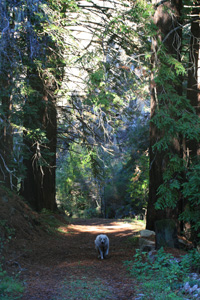
1. Red following me up the redwood canyon from the beach. She goes slowly because there’s so much to inspect. I saw weird mushrooms, flowers, and bobcat tracks. The Whistler-Wilson Ranch is unusual in that it has native redwoods and Monterey Pines growing next to each other.
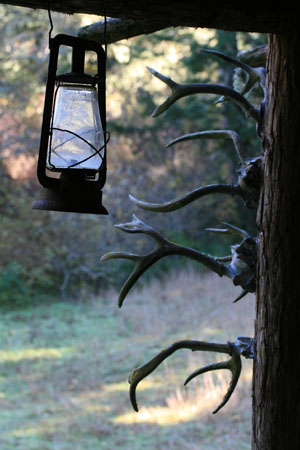
2. We got to the old cabin and looked out at the meadow from the porch. You feel like you’ve gone back a hundred years here.
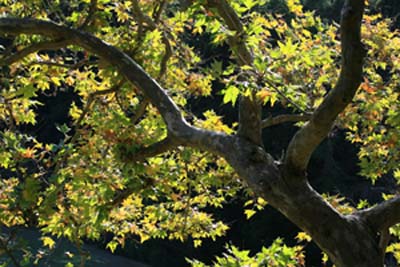
3. I started up the hill and looked back through the sycamore trees at the meadow. The hills are steep so as you ascend you go through different ecological zones quickly.
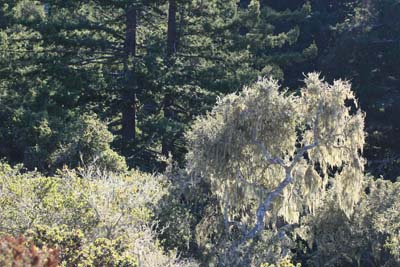
4. Sycamores like the wet canyon bottoms. After leaving them we came to the live oaks shrouded in Spanish moss. Spanish moss is a lichen and it’s very sensitive to air pollution. You can tell the air is clean here from all the lichen hanging from the branches.
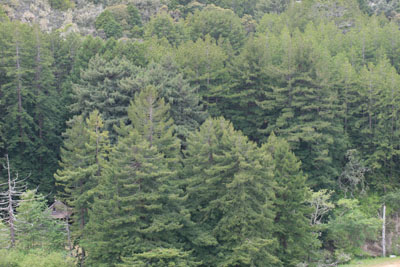
5. When we got up higher we could look down on the hunting cabin tucked away in the redwoods.
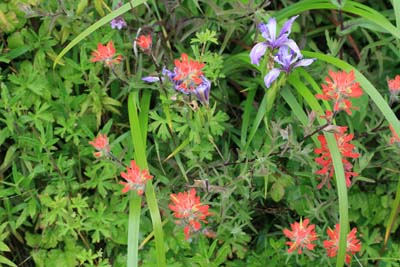
6. On the south facing slopes there were early wildflowers; Indian paintbrush and wild iris.
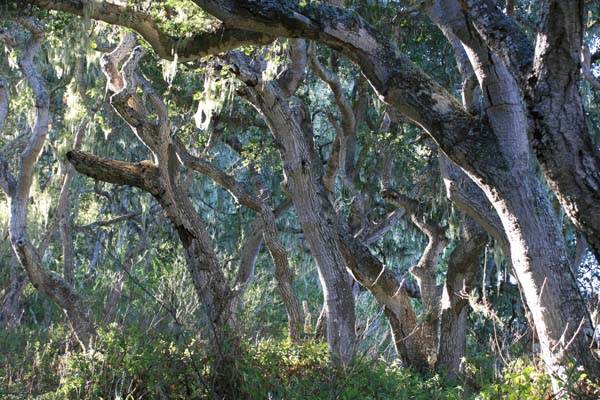
7. Back into the oak forest on the north facing slope.
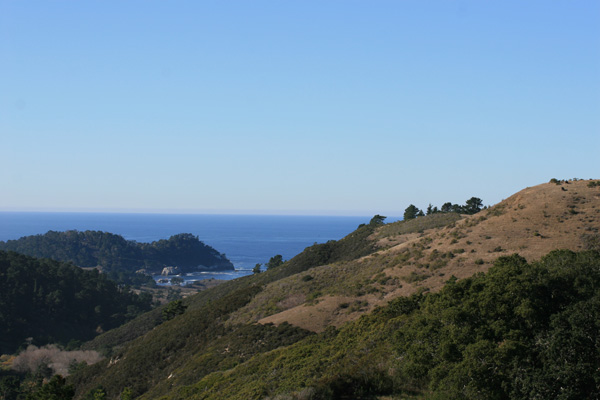
8. And voila! Up on top of the hill looking down on Point Lobos. Preserving this property is a significant step in preserving the integrity of a very sensitive and vulnerable ecosystem.
The Checkered Flag
The hare broke cover at the corner of the rosemary patch and lit off. My dog lunged. The leash jerked from my hand and the chase was on. Yes, there is a clause in my farmland lease contract that stipulates I must keep dogs leashed at all times, but who can hold back nature? Red can’t help herself. And the jack rabbit; well he’s one of those twisted Lagomorphs who finds pleasure in danger. Don’t think “plump, naughty, little Peter Rabbit who sneaks into Farmer Griffin’s garden for a nibble of lettuce and then loses a shoe and a blue coat with brass buttons.” No; we’re talking about Peter’s brazen, shameless, wild-eyed cousin, Jack, who loiters in the herbs and eats my vegetables to feed his hunger for speed. Jack probably smokes Marlboros when he’s filling up at the gas pump too. He’s that kind of bad, bad bunny.
I raise rosemary because the herb complements the potatoes I grow, both on the plate and in the field. Rosemary is a perennial. I need my farm-scape to display a patchwork of short term annual crops, like carrots, and longer term annuals, like tomatoes, mixed with permanent, perennial crops. That way, when our tractors are turning under one block of soil, the beneficial insects that live on the farm,  like ladybugs, always have a place to take shelter that’s close by. If I turned all the soil over at once, or even if I turned it all over frequently, I’d break the life cycles of the beneficial insects and scare off the birds that I need as allies. Of course, no system is perfect. So the rosemary patch which theoretically gives cover to the quail that eat the ants that would otherwise carry aphids to the cabbages– well, crazy hares live there too. I could shoot Jack, I guess, but that would make Red sad. She loves the chase.
like ladybugs, always have a place to take shelter that’s close by. If I turned all the soil over at once, or even if I turned it all over frequently, I’d break the life cycles of the beneficial insects and scare off the birds that I need as allies. Of course, no system is perfect. So the rosemary patch which theoretically gives cover to the quail that eat the ants that would otherwise carry aphids to the cabbages– well, crazy hares live there too. I could shoot Jack, I guess, but that would make Red sad. She loves the chase.
Jack scampered down the dirt road that runs along the levee at the edge of the farm. True, with two hops he could’ve cleared the levee, then dashed down into Pacheco Creek and lost the mutt in the riparian thicket, but where’s the fun in that? Besides, Red was doing well. It’s been a dry winter. The dirt road was hard-packed, without the dust that comes with the heat of summer. Red had muscle, drive…. and traction. Jack looked in his rear view mirror, saw the dog gaining ground, and eased into second gear. Red stretched her legs out. Jack laid his long ears back just a little and executed an instantaneous, 90 ̊ hard left turn into the fava bean patch. But this wasn’t Red’s first race down this track. She cut the corner off the right triangle with a vengeance and ripped a hellish hypotenuse through the beans.
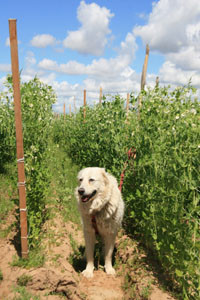
Besides being a dry winter, it’s been cold. We got the fava beans in on time, but the persistent low temperatures throughout December and January stunted the crop’s growth. So now, at a time when our earliest sowing of fava beans are usually a good three to four feet tall, we’ve got long rows of plants that are only two feet tall. I couldn’t get too mad at Red for trashing some beans; I’ll probably turn them under for fertilizer rather than harvest them anyway. We’ll pick our fava beans from the plantings that were sown recently under warmer conditions.
The Jack rabbit passed through the favas and headed out into a large block of ground planted in a cover crop of oats. This was our last cover crop to go into the ground and the oats are only three inches tall. When they’re three feet tall in April we’ll turn them under to add carbon to the soil, then plant the piece out in tomatoes and sweet peppers, but right now the field looks as well-groomed as a golf course, the soil level, smooth and firm. It was a beautiful sight; the buff-colored hare, his long, black-tipped ears cocked back to 45 ̊ now, running smoothly, hitting on all eight cylinders across the manicured green; the fluffy, white dog racing at full speed under blue skies, running as if it were her life that depended on a first place finish.
Our field of young oats doesn’t go on forever, and the bunny knows this better than anyone. There’s a pond at the edge of the field. Jack doesn’t like to swim. So before he hit the water he hit the brakes and did an amazing 90 ̊ left, followed by another immediate 90 ̊ left– a perfect 180 ̊ keyhole turn– and passed Red at a terrific clip, going in the opposite direction. The dog took a frantic turn, went into a sloppy drift that sent turf flying, dug in anew and hit the gas. Jack was way ahead for the moment, but moving into broken ground, a spent patch of rapini, recently plowed, with lumpy clods that are rough on the paws. The dog, with her longer legs and bigger feet, did better on the blocky ground and was making up for lost time.
But wait! What’s this! All the hopped up kinetics and the “hare-pin” turns seem to have molested the gang of fleas that live behind Jack’s ears. The fleas are digging in and holding on for dear life, and the itching is driving Jack mad! He has to stop and scratch! But Red is protected from fleas by FRONTLINE PLUS for dogs©– she ought to have a decal on her bumper– and she’s catching up. She can almost see the checkered flag!
But Jack punches it out of the pit, floors it, gets to sixty in two seconds, makes an evasive maneuver under the picnic table where Nato, the tractor driver, eats his lunch, dodges a pile of sprinkler pipes and two trash cans, crosses the work area where Rogelio is scrubbing radishes, and makes a hard left on to the straightaway by the spring crop vegetables in the front field. Red is slowed by the obstacles. And her feet hurt now after scrambling over all those big clods. But Red reaches deep for one more burst of speed and flies past Rogelio, barking in rage. So Jack pops it into fourth gear, and pours on the coal. There are flames shooting out of his tail pipe now and his ears are flat back. He’s hot-rodding for the San Benito County line like a good ‘ol boy running white lightning, the rows of lettuces, cauliflower, broccoli, and beets all blurring together into a green mist.
Poor Red; she gave it all she had, but she gave up when she caught up with Jack’s sonic boom near the wash tank. Her feet were smoking, she was out of breath, and the crew was laughing. Red stood in a puddle to cool off her paws and sulked. I arrived and gave her a big hug; “It’s ok Girl,” I said. “There’s always tomorrow.”
Article & Photos of Ladybug alighting and of Red by Andy Griffin.
Photo of Jack Rabbit by Jim Harper.
—–
Big Sur Land Trust Benefit Dinner: March 16th & 17th
 Last year I joined the Board of Trustees of the Big Sur Land Trust. The organization is hoping I can add a farmer’s perspective to the board’s deliberations. I’m looking forward to an opportunity to give something back to this community that has supported me and I want to start with a benefit dinner March 16th and 17th at Happy Girl Kitchen in Pacific Grove. You’re invited. (Photo, left, of Glen Devon Ranch by Andy Griffin.)
Last year I joined the Board of Trustees of the Big Sur Land Trust. The organization is hoping I can add a farmer’s perspective to the board’s deliberations. I’m looking forward to an opportunity to give something back to this community that has supported me and I want to start with a benefit dinner March 16th and 17th at Happy Girl Kitchen in Pacific Grove. You’re invited. (Photo, left, of Glen Devon Ranch by Andy Griffin.)
I’m hoping to raise a thousand dollars for the Big Sur Land Trust to have on hand to help school districts and youth groups transport kids to visit these properties for outdoor education. It’s not enough for us to buy land for parks, or pay for scenic easements, or preserve our watersheds and farm lands through conservation easements. If future generations of kids coming up here don’t have a sense of connection to the lands that sustain them, if they don’t learn to feel a sense of community with the plants and animals of the land, if they feel no kinship or interdependence with the farmers and ranchers and foresters that maintain the land, then our future is in jeopardy. There are a lot of children who don’t have an opportunity to visit parks and farms and ranches. Schools are in trouble and they can’t afford field trips. The Big Sur Land Trust is acting to span that gap between our social needs and our public resources. Help be a bridge.
Besides, it’ll be a good meal. Here are the details:
- The vegetarian meal will be prepared at Happy Girl Kitchen in Pacific Grove by John Madriaga. John is a Manresa alum, who has worked at the world-renown Noma, in Copenhagen, and he is currently sous chef at Spruce in San Francisco.
- Happy Girl Kitchen is charging $55 dollars for the meal. I’m asking for an extra $20 per plate as the benefit contribution to the Big Sur Land Trust. I’m donating all the produce from my farm for the event. Carmel Valley’s Heller Estate winery will be pairing wines for each course for an extra $20 dollars.
- You can sign up for the meal at Happy Girl Kitchen. Dinner dates are Friday, March 16th OR Saturday, March 17th.
- Inform yourself about the Big Sur Land Trust and its mission.
- Here’s a link to a story about one of the youth groups the BSLT has hosted on the land at Glen Deven Ranch.
- Take a look at some of the pictures I’ve taken on the Big Sur Land Trust properties at the I-Heart-Big-Sur-Land-Trust Facebook page.
- If you can’t make the meal, consider making a contribution anyway and write a check to the Big Sur Land Trust and send it to Shelley at Mariquita Farm, P.O. Box 2065, Watsonville CA, 95076, and we’ll see that it gets bundled with all the other donations from the meal and delivered to the Trust.
We look forward to seeing you there!
You’re Invited
When I was a child my Grandma took me to Natural Bridges State Beach outside of Santa Cruz where the ocean waves had carved unusual arches in the cliffs. When her father had taken her to that beach in 1905 there had been more “natural bridges” than there are now. Several of the sandstone “bridge spans” had been washed away, and now only their pillars remain as islands. Even rocks don’t last forever.
It wasn’t until 1933 that the State of California bought the land and made a park at Natural Bridges so that future generations, like mine, could enjoy the beauty of the scenery there. Today Santa Cruz has grown up around Natural Bridges and the park is no longer “outside” of Santa Cruz. But even without all of its iconic, wave-washed arches the park means more now to the community than it ever has; not only as a refuge for us from the noise and bustle of town, but as a Monarch Butterfly sanctuary and wetlands for frogs and waterfowl.
When I was growing up my parents took me camping and hiking all over the Monterey Bay Area and I learned to love this whole region as my home. Today my horizon is still framed by the mountains that surround the Monterey Bay. This is where I’m raising my children and where I farm my vegetables. I’ve enjoyed taking my kids to the beaches and forests that I enjoyed getting to know when I was young. It came as a pleasant surprise when I looked up from my work and realized that there are actually more lands set aside for recreation than there were when I was their age.
As I thought about it I realized a deeper transformation is at work than an incremental spread of a few parks. Society used to be enchanted with the “Monumental.” Beautiful, dramatic spots like Natural Bridges were once seen worthy of preservation for their scenic value. But now, as a society, we’re beginning to see the inter-connectivity and interdependence of all life- and to act on it. We now understand that landscapes and watersheds must be protected even where they’re not obviously “Monumental” in nature.
We humans are not the only players on this stage. We depend on a web of relationships to sustain us. The landscape we inhabit here on the central coast may be dramatic, but the less obvious relationship between healthy soil, clean water, biodiversity, unpolluted air, and open space is what makes our lives here sustainable and enjoyable. So I chose to support the Big Sur Land Trust.
The Big Sur Land Trust (BSLT) buys or helps other groups to buy lands that serve as critical habitat for plants and animals and parklands and watersheds for people. Palo Corona Regional Park in Carmel and the Marks Ranch (photo right) addition to Toro Regional Park near Salinas are two examples of the BSLT’s work. But our local, state and Federal Governments can’t afford to buy or maintain the whole landscape in parks. And I’m a farmer; I know we need to produce food somewhere. My family has lived in this area for over a hundred years; I know we need to build houses somewhere. Besides, the Government is hard pressed right now to care for the land it already controls.
The Big Sur Land Trust also buys or creates conservation and scenic easements that act to preserve the scenic integrity of the landscape, conserve resources, and maintain the agricultural economy for all of us while sustaining the working character of the  lands. The Dorrance Ranch atop Mt. Toro and the Violini Ranch on Tularcitos Ridge are two salient examples of conservation easements at work that everybody who lives in view of these mountains enjoys, even if they don’t know about the BSLT. All totaled, in an arc that stretches from the southern Big Sur Coast down by Lucia all the way to Monterey Bay and then down the Salinas Valley all the way the way to Arroyo Seco, the BSLT has created over 50 conservation easements.
lands. The Dorrance Ranch atop Mt. Toro and the Violini Ranch on Tularcitos Ridge are two salient examples of conservation easements at work that everybody who lives in view of these mountains enjoys, even if they don’t know about the BSLT. All totaled, in an arc that stretches from the southern Big Sur Coast down by Lucia all the way to Monterey Bay and then down the Salinas Valley all the way the way to Arroyo Seco, the BSLT has created over 50 conservation easements.
To complement these conservation easements and to encourage our economy towards a more environmentally sustainable path, the Big Sur Land Trust has taken on the goal of encouraging the public to support the local farms and businesses that manage the land and depend on it. I can get behind that! Last year I joined the Board of Trustees of the Big Sur Land Trust. The organization is hoping I can add a farmer’s perspective to the board’s deliberations. I’m looking forward to an opportunity to give something back to this community that has supported me and I want to start with a benefit dinner March 16th and 17th at Happy Girl Kitchen in Pacific Grove. You’re invited.
Why Happy Girl Kitchen? Well, Todd and Jordan asked me to help them host a dinner there, for one thing. Then too, Todd and Jordan are once-upon-a time employees (Jordan was our first CSA driver) and they’re good friends of ours. I have enjoyed watching their business grow. The Happy Girl Kitchen is precisely the type of sustainable, locally-based business that the farmers and consumers in this area need. Plus Todd and Jordan and their staff at Happy Girl Kitchen have created a great little restaurant.
So what’s the benefit for? I’m hoping to raise a thousand dollars for the Big Sur Land Trust to have on hand to help school districts and youth groups transport kids to visit these properties for outdoor education. It’s not enough for us to buy land for parks, or pay for scenic easements, or preserve our watersheds and farm lands through conservation easements. If future generations of kids coming up here don’t have a sense of connection to the lands that sustain them, if they don’t learn to feel a sense of community with the plants and animals of the land, if they feel no kinship or interdependence with the farmers and ranchers and foresters that maintain the land, then our future is in jeopardy. There are a lot of children who don’t have an opportunity to visit parks and farms and ranches. Schools are in trouble and they can’t afford field trips. The Big Sur Land Trust is acting to span that gap between our social needs and our public resources. Help be a bridge.
Besides, it’ll be a good meal. Here are the details:
- The vegetarian meal will be prepared at Happy Girl Kitchen in Pacific Grove by John Madriaga. John is a Manresa alum, who has worked at the world-renown Noma, in Copenhagen, and he is currently sous chef at Spruce in San Francisco.
- Happy Girl Kitchen is charging $55 dollars for the meal. I’m asking for an extra $20 per plate as the benefit contribution to the Big Sur Land Trust. I’m donating all the produce from my farm for the event. Carmel Valley’s Heller Estate winery will be pairing wines for each course for an extra $20 dollars.
- You can sign up for the meal at Happy Girl Kitchen. Dinner dates are Friday, March 16th OR Saturday, March 17th.
- Inform yourself about the Big Sur Land Trust and its mission.
- Here’s a link to a story about one of the youth groups the BSLT has hosted on the land at Glen Deven Ranch.
- Take a look at some of the pictures I’ve taken on the Big Sur Land Trust properties at the I-Heart-Big-Sur-Land-Trust Facebook page.
- If you can’t make the meal, consider making a contribution anyway and write a check to the Big Sur Land Trust and send it Shelley at Mariquita Farm, P.O. Box 2065, Watsonville CA, 95076, and we’ll see that it gets bundled with all the other donations from the meal and delivered to the Trust.
Article & Photos by Andy Griffin.
Rain
 It is the middle of the night, and I can’t sleep. I can hear the rain on the roof, and I’m measuring it; not in inches or in centimeters, but in my mind, adding up the chores accomplished in time and subtracting the tasks left undone.
It is the middle of the night, and I can’t sleep. I can hear the rain on the roof, and I’m measuring it; not in inches or in centimeters, but in my mind, adding up the chores accomplished in time and subtracting the tasks left undone.
I can hear the logs burning in the fireplace too. I’m glad I spent time last week cutting up dead, fallen branches in the forest. Now I’ve got a couple of months’ worth of dry wood cut, split, and stacked in the shed. The house won’t be damp and cold and my family won’t be crabby. That’s a plus!
Our cat, Sarah, is in the living room, in front of the fire, “toughing it out” on her tuffet. She’s happy. Rain tests all the preparations I’ve made to care for the animals. How have I done? My dog, Red, is happy; she’s in my room sleeping on her fleece by my bed. She snores. Blue, our other Pyrenees Mountain dog, is asleep in the shed outside. He’s so fluffy he may not even be aware that it’s raining. My two donkeys, Prima and Sweet Pea, have noticed the precipitation and they’ve retreated to their dry shed. The goats are in the barn. Only my cows are out in the wet night, but they’ve taken shelter down in the oak trees. Besides, my cows are Dexters; fat, little, heirloom Irish cows, and a light California rain doesn’t alarm them.
I do hope the rain gets heavier. For the past month I’ve kept the cattle in the pasture next to our house so that I can more easily feed them hay. There’s been so little rain this winter that the grass hasn’t grown like I need it to. I plan on keeping the cattle off of their regular pasture for another month or so. With the nights getting a little shorter and a little warmer the grass will soon get a little longer— if there’s enough rain. I can’t afford to feed the cattle hay all summer, so if it doesn’t rain I’ll have to sell them.
The rain is good for the vegetables too. Crops always grow faster after a rain than they do after an irrigation. The water’s cleaner, I guess. Rain is certainly cheaper than irrigation. I’m short on irrigation pipes right now, so a rain means I don’t have to spend money to move pipes. It doesn’t cost me anything to move clouds! The rain means lower power bills too. If the rain is going to do the irrigation for us we can spend our money to harvest crops. I’ve got cauliflower, carrots, yukina, cabbage, spring garlic, nettles, escarole, and lettuce planned for harvests this week, plus some potatoes out of the cooler. It’ll be a muddy day in the fields, but do-able.
Of course the rain slows some things down. We got ½ of our last winter cover crop planted yesterday before we ran out of seed. Now it will be too wet to plant for a while, which gives me time to get down to King City and buy more cover crop seed. I’d better take more seeds in to Headstart Nursery too. They grow my vegetable transplants. If I can’t sow directly into the field I have them start seedlings for me for transplant out later so that I don’t get off schedule.
It’s awfully early in the year to know how we’re doing, but so far things seem good. We’re on time with our plantings, things are growing, it’s finally raining, the house is warm, and the cat is in front of the fire. It all adds up. Time to go to sleep.
Article and all photos by Andy Griffin.
———
We continue to send out weekly newsletters with Andy’s writings, recipes, and more with our Ladybug PostCard. Sign up here.
Vegetable Recipes A-Z
Ladybug Truck Deliveries this week! Palo Alto, Santa Cruz (both on Wed) and Incanto in SF (Thurs) Incanto Restaurant
Upcoming dates: sign up for your region to get the announcements:
Wed. 2/22 West Menlo Park
Wed. 2/22 Los Gatos
Thu. 2/23 Camino/Oakland
Sat. 2/25 Cotogna/SF
Our ‘traditional’ CSA starts in March: Info
Reflections
There’s no law that says a Christmas tree has to be a pine. When I was a kid my neighbors always cut down a big Manzanita bush for their tree. Manzanita works well because the twigs are rigid and support the weight of ornaments and lights well and the very spare foliage neither wilts nor obscures the smooth, red, and muscular, twisted branches. Some people might say that Manzanita isn’t a very traditional choice for a Yule tree but community consensus over tradition isn’t one of our strong points here in California; Me, I like the outstretched arms of a cactus tree to hold up my string of 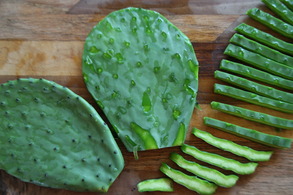 lights.
lights.
My Christmas cactus is a prickly pear that I have pruned and shaped for 25 years. I’d been on a hiatus from farming, doing some ornamental gardening in Santa Barbara, and I’d learned to appreciate xerophytic landscaping. The last thing I did before I moved to Watsonville was cut a cactus paddle from a favorite plant near the Mission to plant at my new home. Now the plant dominates our yard.
My intentions were ornamental but the Mexicans I lived with gave me a working vocabulary for my cactus; the plant itself is called a nopal, the paddles are called pencas, the fruits are tunas, and nopalitos are the tender, young pencas that are harvested and cooked. Nopalitos taste not unlike green beans. I like them. In Old Mexico they are traditionally served with eggs or beans at breakfast. Considering how nutritious nopalitos are, how economical the plants are with water, and how hardy they are, the Nopal cactus may be the most under-appreciated vegetable resource in the world.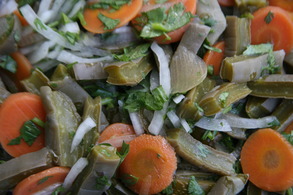
My family is not always as enamored with the cactus tree as I am; it does have spines and its long branches threaten visitors as they approach the house, but no one ever said I was easy to live with either. Last Saturday, as dusk darkened into night, I stepped outside to try and photograph my Yule Nopal. I was charmed to see Julia working away at her computer in the kitchen, framed by a halo of reflected Christmas lights. It was a quiet, “reflective” moment in the hectic life of our family and farm and I’m happy with how the picture came out. (pictured below)
My photo of the Christmas cactus is a “seasonal” picture for us, because not only are colored lights “seasonal,” so is the reflective mood the lens captured. December is one of the quietest months on the farm. We don’t do much planting now, although I will put in some lettuces this week for March harvest. Mornings can be frosty, so we often start the harvest late, so as not to damage our crops by handling them. Night comes early, so we stop work early. December is a good time of year to slow down, look back on the things that worked, ruminate on the things that didn’t, and catch up with all the undone tasks.
For her part, Julia has been plugging away at the computer, revising the recipe files for the website, linking photos to recipes, and in general trying to make the “web support” we can offer our CSA subscribers as useful as possible. She’s giving me a list of vegetables we need photos (or better photos) for so that I can remember to “capture them on pixel” the next time I have the opportunity. I’m giving her all my nopal pictures now.
We wish you all a reflective and peaceful holiday season too.
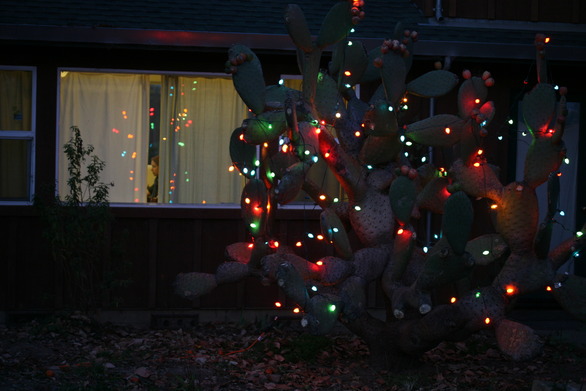
Article and all photos by Andy Griffin.
Nopalito Recipes || Vegetable Recipes A-Z
 ** Julia’s note: the Nopalito recipe page has a couple of recipes from a thorough cookbook I got from my grandmother: The Cactus Cookbook: Succulent Cookery International, published 1971 by Joyce L. Tate and the Cactus and Succulent Society of America. It has hundreds of recipes: many of which would pass any slow food test, many others that are bizarre concoctions that include jello and other canned vegetables/fruits. I looked on ABE books and there are many copies available for those of you interested in making your own Opuntia Jelly, Cactus Pear Harvest Relish, Nopalitos Souffle, Stuffed Cactus Stems with Cheese, Prickly Pear Beer, Barrel Cactus Pudding… you get the idea!
** Julia’s note: the Nopalito recipe page has a couple of recipes from a thorough cookbook I got from my grandmother: The Cactus Cookbook: Succulent Cookery International, published 1971 by Joyce L. Tate and the Cactus and Succulent Society of America. It has hundreds of recipes: many of which would pass any slow food test, many others that are bizarre concoctions that include jello and other canned vegetables/fruits. I looked on ABE books and there are many copies available for those of you interested in making your own Opuntia Jelly, Cactus Pear Harvest Relish, Nopalitos Souffle, Stuffed Cactus Stems with Cheese, Prickly Pear Beer, Barrel Cactus Pudding… you get the idea!
New and Improved!
 The seed catalogs are landing in my mailbox. I’ll read them all with a mix of professional interest, curiosity, amusement, and horror. If you will consider seed catalogs to be a form of literature for a moment– a sub-genre of fantasy, perhaps– then I’ll volunteer to be a literary critic. What? You think they’re nonfiction? Seed catalogs sell a fantasy of summer, and what better time is there for that when the chilly winds of winter blow? In fact, the first catalog to arrive this year was Totally Tomatoes, which is as focused on summer as any catalog can be and I’ll get to it in a moment, but first, a few words about love and cigars.
The seed catalogs are landing in my mailbox. I’ll read them all with a mix of professional interest, curiosity, amusement, and horror. If you will consider seed catalogs to be a form of literature for a moment– a sub-genre of fantasy, perhaps– then I’ll volunteer to be a literary critic. What? You think they’re nonfiction? Seed catalogs sell a fantasy of summer, and what better time is there for that when the chilly winds of winter blow? In fact, the first catalog to arrive this year was Totally Tomatoes, which is as focused on summer as any catalog can be and I’ll get to it in a moment, but first, a few words about love and cigars.
There are so many varieties of love; romantic love, unrequited love, lost love, maternal love, and the love we have for our pets, just to name just a few. The writer who takes on love as a subject has an endless amount of material to work with. I’m not saying that love is easy to write about. We all experience love, even when we only feel it as a hunger, so every reader is potentially as much an expert as any author. Writers who choose to explore more technical subjects, like cigars, face a different challenge. I don’t smoke, but I have found myself reading Cigar Aficionado Magazine from time to time. “Cedar notes? With accents of autumn leaves?” I like to see how the editors labor to present cigars anew, month after month. I look for the rhetorical tricks that are employed to get readers like me to smell the cedar. Writing for an annual seed catalog with over 30 pages of glossy photos and mini essays dedicated almost entirely Solanum lycopersicum, must be a difficult task.
In catalog world, novelty sells. “New and Improved!” But tomatoes, like their close cousins, the tobaccos, were first cultivated by Pre-Columbian Native Americans, so what can possibly be new? For 2012 Totally Tomatoes presents for the very first time “Tasti-Lee™ Hybrid tomato with up to 40% more lycopene than other leading varieties of tomato.” Lycopene is a red pigment with antioxidant properties. According to some preliminary scientific findings there is an inverse relationship between eating a lot of tomatoes and cancer risk, especially prostate cancer. As a tomato grower I’d like this to be true, but I’m not “sold.”
Before I put any credence in any scientific claim any catalog makes I read it from cover to cover and look for the most egregiously manipulative and fraudulent claim. “Aha!” I say when I find it. “This is how low they’ll go!” On page 25 Totally Tomatoes presents the “Peron” tomato, billed as “The world’s only sprayless tomato, requiring no pesticides.” I never use any pesticides on any of my tomatoes. Just for good measure Totally Tomatoes also says that Peron has 2.5% more vitamin C than the other leading breeds. I suspect that catalog writers twist “recent studies” into creative ad copy whenever the variety that they’re writing up doesn’t give them anything more concrete to work with.
Names count for a lot in catalog literature. A good product name evokes the values that the buyer treasures. For a gardener the size of fruit may be important, as well as the earliness of the harvest, and the potential profitability quotient. Throw in an appeal to ethnic identity and timeless family values and a catalog writer has all the bases are covered. Totally Tomatoes doesn’t disappoint; the reader gets “Goliath,” “Early Goliath,” “Goldrush Goliath,” “Italian Goliath,” and – I kid you not- “Old Fashioned Goliath ™ Hybrid VF.” Don’t you hunger for the “good old days” when peasants named the hybrid fruits of their labors after their Biblical heroes, then trademarked their creations and used their profits to hire lawyers?
But let’s not forget color. Getting paid to write for a catalog where you need to say something unique and appealing about hundreds of different kinds of red ball-shaped is enough to make a poet out of a person; in Totally Tomatoes there are descriptions of fruits with “red,” “deep red,” “bright red,” “shiny red,” and “intense red.” It must be a relief for the writers that there is so much contemporary consumer interest in heirloom tomatoes with their oranges, greens, purples, yellows, and stripes. I give Totally Tomatoes credit for carrying many heirloom varieties. Crafting the story lines behind these antique, open pollinated breeds of tomato that have been passed down through the generations gives the catalog’s writers some room to stretch out and tell a good tale. One quibble with the storyline though; “Old-Fashioned” is not a flavor, it’s a rhetorical crutch, a phonetic catalyst designed to evoke sepia toned nostalgia for better times that probably never existed. But that’s ok. I’m not looking for Steinbeck in the seed catalog. The appeal to “Old-Fashion Values” is only the flip side of “New and Improved” which plays to our utopian hopes of a shiny, bright future.
So what do I look for?
 As a grower I want to know if the tomato variety is determinate or indeterminate. Determinate tomatoes set almost all their fruit at once. This is a convenient trait for large-scale growers who harvest their crop with machines. I prefer to harvest more modest amounts of fruit by hand every week over a long season, so I look for indeterminate varieties. Growing indeterminate tomatoes allows me to find markets for my harvest, even out my cash flow, and keep my crew gainfully employed for months.
As a grower I want to know if the tomato variety is determinate or indeterminate. Determinate tomatoes set almost all their fruit at once. This is a convenient trait for large-scale growers who harvest their crop with machines. I prefer to harvest more modest amounts of fruit by hand every week over a long season, so I look for indeterminate varieties. Growing indeterminate tomatoes allows me to find markets for my harvest, even out my cash flow, and keep my crew gainfully employed for months.
I’m always curious to know what the disease resistance of the plant is. I don’t use fungicide, so I’m always looking for crops which are resistant to pathogens. That’s been the problem I’ve had with some Italian heirloom tomatoes I’ve trialed with disappointing results. Each heirloom tomato evolved under different conditions with different amounts of humidity to contend with, different soils, and different pests. Some varieties work here, some don’t. I don’t expect a catalog like Totally Tomatoes with ambitions of a continental reach to be able to tell me what will grow well on my farm in San Benito County. Trial and error is my best guide.
Flavor is important. “Old-Fashioned” may not mean anything, but before I try a new variety I do want to know what the acid/sweet balance of the fruits is. I like to know what the texture of the fruit is like too and how uniform the fruit size is too. Size is important, but bigger is not necessarily better. Huge fruit can be hard to pack, and if a crow takes one peck out of a huge tomato I lose a lot. I prefer a plant that gives me a lot of smaller fruit, so Mr. & Mrs. Crow can wet their beaks without leaving me broke.
Flavor has a lot to do with cultural practices, so I like to know if a particular variety of tomato tolerates “dry-farming.” By not watering the tomatoes the plants are forced to reach deep into the mineral earth for their water, and in so doing they gain access to all the trace elements and micro-nutrients that make for good flavor. Nitrogen, phosphorus and potassium, or NPK, might be the most important fertilizers for vegetative growth, but it’s all the trace elements that give character to flavor. Some tomatoes will tolerate dry farming conditions and some won’t. Because successful dry-farming is so dependent on local conditions national catalogs can’t really honestly address the issue. Most, like Totally Tomatoes, don’t even bring it up.
So, will I buy anything from Totally Tomatoes?
Yes, I will. “Early Girl” is a hybrid tomato offered by Totally Tomatoes that is indeterminate, disease resistant, flavorful, and adapted to dry-farm culture and I will buy 15,000 seeds. The rest of my tomato seeds I will either save from my own crop, like Principe Borghese, or buy from Johnny’s Seeds. Johnny’s Seeds doesn’t carry Early Girl but they are sensitive to the needs of small-scale organic and specialty growers and they offer many varieties of tomato. For the record, the Johnny’s catalog is the clearest, most informative one out there. I keep it by my bed.
Andy Griffin || all photos by Andy Griffin || Tomato Recipes, of course!
——-
Recipes A-Z from our farm
Bulk Deliveries to many Bay Area locations: Ladybug Truck Farm
Mariquita Farm CSA
Photo Gallery
Saving Seed
 The room where I sleep is a scene of disorder and mayhem. That’s nothing new, I suppose, but it smells like a shed, too. I blame the weather! First of all, I have no nice, dry, mouse-proof shed in which to store my crop of Indian corn, so when the sky clouded up last week I had my kids help me stack all the totes of corn inside the house at the foot of the bed. Then last Saturday was all about seed saving; I butchered 10 Galeaux d’Esyines pumpkins and scooped out the seeds, washed them free of their sticky entrails and spread them on a cardboard panel to dry- in my room. Two chilacayotes went under the knife too, followed by two Calabasas de Castilla. Then I switched over to peppers and cleaned some Padron, Friarelli, Goat Horn, and Carmagnola peppers for seed. It was cold outside where I was working so I built a fire, and I plugged in the radio so I could listen to “This American Life” as I worked. As I cleaned the peppers I put the seeds into dishes to dry. But even before I was done, and even with the flames and the smoke and NPR droning away, little birds started to swoop down and raid my seed dishes. So the pepper seeds went into my room too. I’m happy that I’ve got so much seed set aside for next year, and I’m confident it will dry out well and that the spicy, funky smell will moderate over time. I can always build a fire in my wood stove and warm up the room if the process appears to be taking too long. Not everybody is happy with the situation, though. My daughter thinks that it’s embarrassing to be related to someone who lives like a peasant, and my dog, who usually shares my values, is annoyed that I moved the fleece she sleeps on by the door to a less convenient location.
The room where I sleep is a scene of disorder and mayhem. That’s nothing new, I suppose, but it smells like a shed, too. I blame the weather! First of all, I have no nice, dry, mouse-proof shed in which to store my crop of Indian corn, so when the sky clouded up last week I had my kids help me stack all the totes of corn inside the house at the foot of the bed. Then last Saturday was all about seed saving; I butchered 10 Galeaux d’Esyines pumpkins and scooped out the seeds, washed them free of their sticky entrails and spread them on a cardboard panel to dry- in my room. Two chilacayotes went under the knife too, followed by two Calabasas de Castilla. Then I switched over to peppers and cleaned some Padron, Friarelli, Goat Horn, and Carmagnola peppers for seed. It was cold outside where I was working so I built a fire, and I plugged in the radio so I could listen to “This American Life” as I worked. As I cleaned the peppers I put the seeds into dishes to dry. But even before I was done, and even with the flames and the smoke and NPR droning away, little birds started to swoop down and raid my seed dishes. So the pepper seeds went into my room too. I’m happy that I’ve got so much seed set aside for next year, and I’m confident it will dry out well and that the spicy, funky smell will moderate over time. I can always build a fire in my wood stove and warm up the room if the process appears to be taking too long. Not everybody is happy with the situation, though. My daughter thinks that it’s embarrassing to be related to someone who lives like a peasant, and my dog, who usually shares my values, is annoyed that I moved the fleece she sleeps on by the door to a less convenient location.  There’s more seed to clean too- Cayenne, Aji Rocoto, and Principe Borghese tomatoes, for example, so the situation will only get worse before it gets better. But once the seed is dry I’ll put it in envelopes and file it away. And once I have the time- probably after Thanksgiving- Kira and Adam are going to help me shell and grind the corn so we can have some fresh cornmeal to sell at our wintertime Ladybug Truck Farm deliveries. Adam and Kira have a bicycle powered corn meal grinder and an old fashioned hand cranked machine that shells corn. That’ll be fun, and once we’re done the house will smell like corn bread baking and my room can go back to looking like something Martha Stewart, my daughter, and my dog can all be proud of.
There’s more seed to clean too- Cayenne, Aji Rocoto, and Principe Borghese tomatoes, for example, so the situation will only get worse before it gets better. But once the seed is dry I’ll put it in envelopes and file it away. And once I have the time- probably after Thanksgiving- Kira and Adam are going to help me shell and grind the corn so we can have some fresh cornmeal to sell at our wintertime Ladybug Truck Farm deliveries. Adam and Kira have a bicycle powered corn meal grinder and an old fashioned hand cranked machine that shells corn. That’ll be fun, and once we’re done the house will smell like corn bread baking and my room can go back to looking like something Martha Stewart, my daughter, and my dog can all be proud of.
Andy Griffin text and photos
———
Upcoming Ladybug Deliveries: mystery boxes, cauliflower and more
11/22 Cotogna/SF 5pm – 7pm
Announcement with info re: this delivery
Order form for Cotogna
11/23 Santa Cruz 12 noon – 2pm (day before Thanksgiving and all)
Announcement with info re: this delivery
Order form for Santa Cruz
Upcoming Dates:
11/30 Palo Alto & Los Gatos
12/1 Camino in Oakland
12/3 Cotogna in SF
12/7 Santa Cruz
12/8 Piccino
12/15 Aziza
12/21 Santa Cruz
12/22 Incanto
and others! we’re working on upcoming schedules. thank you. -Julia & Shelley
please add your email addresses to the locations:




